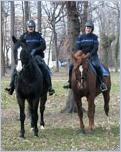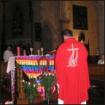 The secret costs of papal visits (1990-2013)
The secret costs of papal visits (1990-2013)
Governments try to keep the costs of papal visits hidden from the taxpayers, especially security, the largest item by far. In Australia the total expenses were even declared a state secret. See also:
♦ The Vatican’s triple crown: church, government and state
♦ Papal pomp thanks to British taxpayers (2010)
♦ Spanish Catholics protest new way to hide papal visit costs (2010)
♦ Security hysteria on the Pope’s trip to Bavaria (2006)
♦ Vatican's “World Youth Day 2005” funded by European Union
♦ Gay Catholic youth not wanted at Australian WYD (2008)
When it comes to papal trips, the pope gets the best of both worlds. He claims the diplomatic perks of a head of state [1] yet as a religious leader he doesn’t hesitate to make politically-charged statements about the policies of his hosts [2] which no real visiting head of state could get away with. “In order for this arrangement to work in any country that has separation of church and state, the papacy must be recognised as both a religious and political organisation.” [3] Then, like any other head of state, the pope gets his trip paid for by the host country, including his travel expenses, his room and board and his huge security bill.
Brazil, July 2013
A poll taken on the eve of the visit of Francis I In 2013 shows why Brazil was a papal priority. In the six years since his predecessor's trip (see below), the number of Brazilians calling themselves Catholic country sank from 64% to 57%. Furthermore, only 5% of these self-professed Catholics said that they voted for the politicians recommended by their Church. And it's not just the laity who have been abandoning the Church. It's estimated that one in four Brazilian priests have left in order to marry. The Brazilians were obviously in need of another papal visit.
Yet, despite much talk from Francis I about helping the poor, his trip to Brazil in 2013 as part of the Catholic World Youth Day was not designed to spare the taxpayers. In fact, he wanted Brazil to give him an additional 39 million US dollars because fewer than half the faithful originally expected appeared to be planning to attend. [4] To try to get more to come, he even announced a special indulgence, understood by many of his followers as removing punishment for their sins. [5]
In a brilliant public relations move, Pope Francis scrapped the 4-ton popemobiles, armoured cars adapted from the kind used by South American dictators and recently imitated by Mexican drug barons. [6] His much-publicised decision to appear in an open-topped Mercedes jeep, instead of an armoured, bullet-proof popemobile, served to escalate the security costs further. It substituted the customary police protection with a massive operation by the military [7] and drafted 14,300 army, air force and navy personnel to boost security for the visit. [8] This puts more responsibility on the security forces and a greater burden on the taxpayer. In fact, his hosts in Brazil became so worried about his safety that they All this obliges the Brazilian taxpayer to foot the huge bill for an event which the Vatican is using to further its own programme. This includes using this World Youth Day to recruit of young people for Opus Dei [9] and to distribute a booklet which claims that “the very nature of woman...is to be a mother.” [10]
Germany, September 2011
Among the groups demonstrating against the papal visit which began in Berlin were former abuse victims and people who grew up in children's homes. They were protesting the roughly €30 million the Church budgeted for the pope's visit ― compared with the roughly €2 million it has paid in compensation to victims of sexual violence to date. [11]
Spain, August 2011
Spanish theologian Evaristo Villar has criticised the “showmanship” of the papal visit, for which a 200-metre (656-foot) long stage was erected at the Cuatro Vientos aerodrome, (decorated with a huge metal tree), and 20 giant screens. [12] He also points to the “opacity” of the state funding for this extravaganza, with up to eight ministries involved, as well as the City of Madrid. [13]
The cost of the Pope’s four-day visit in connection with a World Youth Day has been estimated by the organisers at 50 million euros ($72 million) and by Europa Laica at far more, when the security and the contributions of local and city governments (and presumably the tax rebates for the corporate sponsors) are take into account. [14] The organisers further claim that 80 percent of the cost of the event will be financed by payments from the young people, with the rest coming from donations by companies and individuals. However, if substantially fewer attendees than the 2 million estimated by the organisers [15] turn up, (and the city government is preparing for just over half of that, “between a million and 1.3 million”) [16] the estimate could well turn out to be a phantasy figure with the public left to pay the debts, as happened in the UK in 2010 and Australia in 2008. (These are the only countries for which, through Freedom of Information requests or Auditor General's reports, reasonably complete figures are known.)
And even this questionable estimate does not include:
— the 38,700 euro grant quietly given by the City of Madrid for a festival and vigil on the two days preceding the main event, which has been called a “hidden subsidy” [17]
— the attendees’ transportation. They get an 80% discount on public transport [18] just a couple of weeks after Madrid metro fares rose by 50% for everyone else [19]
— the bills for electricity, water etc for the 693 buildings where the young people will be staying [20]
— the cost to the economy of closing large sections of central Madrid for the six-day event [21]
— the tax rebates to the sponsors, many of them wealthy international concerns, for 80 percent of their donations to the Pope [22] and
— security, which is always the biggest cost and therefore never publicised. The Spanish Government has said only that there will be 10,000 police officers on duty to avoid “incidents” between the WYD pilgrims and those “outraged” by the costs to the public. [23]
Many sections of Spanish society protested against the cost to the public purse of the Pope’s evangelising event. These included:
— unions of the police, emergency services and staff of the state schools, colleges and sports facilities where the attendees will be billeted. They have protested at having to cancel their annual August holiday. [24] Two of their union leaders have questioned why the attendees should even be billeted in state facilities, suggesting that they stay instead in private accommodation and Church schools. This would help “maintain the secular character of the Spanish State”. [25]
— a group of liberal Catholic organisations, [26]
— an association of 120 Madrid priests, (Foro de Curas de Madrid) which wrote a frank open letter criticising the ostentation and expense of the papal visit [27] and
— an umbrella group of 44 organisation, both secular and Catholic. These have united under the motto “No taxes from me for the Pope” (“De mis impuestos, al Papa cero”) One of its spokesmen said that the World Youth Day did “not even represent all Catholic youth, only the more fundamentalist”. [28]
Spain, November 2010
The pope's two-day visit was reported by the Spanish media to cost the Spanish taxpayers 14.5 million euros and the Catalonians 2 million more. And this, according to the Barcelona Cardinal, did not include security expenses or the cost of a media centre. The public transport section of the CGT union called a one-day strike in Barcelona “against the spending of public money during the visit of the pope.” This money should instead fund free public transport for the Catalan unemployed, it said in a statement. [29]
United Kingdom, September 2010
How much did the Pope’s trip to Britain in September 2010 cost the nation? The UK Government won’t say. Between the announcement of the Pope’s first state visit to Britain until he arrived half a year later, the projected costs that were acknowledged rose by about a half, while the Government managed to keep secret many other expenses, including the enormous security bill. And it has slipped out that to help pay for the Pope’s visit the UK Government quietly diverted money meant for aid to the world’s poorest people. For the full story see: Papal pomp thanks to British taxpayers
Cyprus, June 2010
In Cyprus the opposition to the papal visit voiced by the religious competition did not appear to be grounded on the principle of church-state separation. The Metropolitan (Bishop) Athanasios of Limassol of the Orthodox Church of Cyprus spoke of the
bulletproof car which cost €500,000 which, I read, the Cypriot government bought for the Pope to travel around Cyprus for the two days he will be here. I was personally quite scandalised by this news ... A bulletproof car does not fit the Vicar of Christ. [30]
Malta, April 2010
The Government claimed that the papal visit would cost €200,000, but this has been called by one of the country’s leading newspapers “not even enough to pay for the overtime of police officers”, let alone the other security costs. [31] On the eve of his visit it was quietly bumped up by a quarter to €250,000. [32]
Furthermore, the Pope’s personal security costs, which were ignored by this estimate, “skyrocketed”, after the trip was planned because of a repeat of the 2008 incident by the same enthusiastic worshipper in 2009. [33] Videos of these incidents show the Pope's black-suited security guards, the vigilanza, springing into action. To minimise the risk in Malta, everyone was pre-screened and its government “accredited some 5,000 persons between guests, staff, personnel from the forces for public order, volunteers, civil protection officials and doctors.” [34]
Not acknowledged as associated with the papal visit is the “extensive work being carried out on the country’s roads, the quality of which has already been questioned.” [35] In addition, thousands of flowers have been planted along the papal route. And at the end of his visit, the Maltese taxpayers will pay to fly him out, just as they paid to bring him there. Air Malta flight KM1950 has been chosen to mark the 1,950th anniversary of St. Paul’s visit to the island. [36]
However, the arrival of St. Paul, which this event commemorates, was somewhat different. His ship struck a reef, the hull broke up and the Saint swam ashore. [37] That apostolic visit was accomplished at no cost to the Maltese taxpayers.
Angola, March 2009
In addition to the cost of the 10,000 police officers, there was security in the form of anti-terrorism measures such as sharpshooters to protect the route taken by the Popemobile. [38] One wonders who protected the poor Angolans from police who are noted for practicing with complete impunity “arbitrary arrests and unlawful detention, torture and ill-treatment, deaths in police custody and extrajudicial executions”. [39]
Australia, July 2008
The price tag that the Church got an Australian premier to conceal has finally been partially revealed by the Auditor General. The hidden figures that he published showed that the papal youth jamboree scared off tourists. On the heels of these embarrassing numbers, the Government of New South Wales belatedly released figures on the budget shortfall of World Youth Day, July 2008. As a visiting head of state, Benedict XVI had his accommodation and (massive) security paid for by his hosts and now the taxpayers will have to come up with 100 million Australian dollars more. [40]
In preparation for the Pope’s visit to Sydney, Australia, the premier of New South Wales had a financial statement drawn up which he said showed the papal jamboree would bring in $150 million Australian. Then the Catholic Church got the Government of Premier Morris Iemma, who happens to be Catholic, to exempt this report from the Freedom of Information Act, claiming it would be against the public interest to allow anyone to check the figures. [41] All that could be gleaned was that $41 million in public funds was paid to the race track where the event was held and it's been estimated that at least another $20 million was spent on security. Not included here is the cost of providing emergency services and of billeting pilgrims in state schools. [42]
Until late November Premier Iemma's government was still resolutely refusing to reveal the price tag for "the joy it brought to our city". Later, however, Tourism Australia released figures suggesting that far fewer attended the World Youth Day than the Church had estimated. And most of the “pilgrims” who did turn up, quite naturally took the free accommodation provided by the state and didn't use hotels. [43] Furthermore, the tourism department's figures indicate that the event actually ended up costing Sydney some 63,000 visitors who preferred not to spend their holiday in a city full of fervent teenagers. Yet even long after the event the information on the government's expenses was still treated like a state secret. [44]
In the wake of news of the tourist shortfall, the financial shortfall was made public when the Auditor General was finally allowed to release his “top secret” report. According to this, the Australian taxpayers will have to pay an additional $100 million AUD. He said that “the estimated final cost for World Youth Day is six times the original budget estimate.” His report says the actual outlays are likely to be $120 million, but that figure would not include a host of costs incurred by other Government agencies, and so the true cost of hosting the event may never be known. [45] For an assessment of the attendance and financial figures see Max Wallace, “World Youth Day wash up”, Online Opinion, 5 February 2009.
France, September 2008
The costs to the taxpayer of the papal visit to Paris and Lourdes from 12-15 September, are still being held secret. However, from the security measures alone it's clear that also this papal visit didn't come cheap. [46] A few highlights:
♦ Two “popemobiles”, each weighing 4 tons, were flown in by military Hercules C-130 transport planes to Paris 10 days in advance so that the police could become proficient in driving them.
♦ In Paris 2000 police formed a network through the capital, the river brigade was mobilised to watch the banks of the Seine, and sharpshooters were posted on high points.
♦ Glass bottles, large flags, banners, posters or signs were forbidden.
♦ About 72 hours before the pope's arrival in Lourdes, the holy site was “decontaminated” by mine detectors.Company Number One of motorcyclists from France's élite riot police controlled the entrance to the football stadium where the pope would hold the rally. The local airport of Tarbes-Lourdes-Pyrénées was guarded by police, while the hills which overlook the town were patrolled by the mounted brigade.
♦ And finally, Lourdes was blanketed with an aerial security cordon extending for 20 kilometres in all directions, where radar, planes and missiles would be prevented from attacking the pope.
What all this security cost the French taxpayers has never been revealed.
Brazil, May 2007
Nor do we know the true cost to the Brazilian taxpayers of the papal visit estimated at 50 million Brazilian reais [47] (about 28 million US dollars or 18 million British pounds) ― a trip which the Pope used to urge the signing of a concordat.
A massive security operation ― the greatest ever adopted in Brazil ― was launched to protect the Pope, with some 10,000 police agents as well as helicopters, cameras and two bulletproof popemobiles. [48] However, at least they didn't have to pay as much as the Vatican was expecting. “Reportedly, the Vatican was quite ‘upset’ that Brazil was unable to organise (and pay for) the Pope’s return air trip to Rome.” [49]
Naturally the Vatican didn't mention that that Brazil might have been upset by the politically-charged remarks of its expensive guest.
On the plane that took him to Brazil, Benedict backed Mexican bishops who threatened to excommunicate Catholic politicians who supported liberalization of Mexico City's abortion law.
Brazilian Health Minister Jose Gomez Temporao took issue with the remarks, saying that women are often left alone in their situation without support from the fathers. He stressed that the issue of abortion is “up to each person's faith” [...] “The minister has to focus on the field of public health,” said Gomez Temporao, referring to the horrific aftermaths of Brazil's many illegal abortions. [50]
Germany, September 2006
Also not revealed are the expenses footed by the German taxpayers from Benedict XVI's first papal trip, (9-14 September 2006). However, in the course of the preparations for it, the president of the Bavarian Police Union, Harald Schneider got a look at the cost of the Pope’s security: €50 million. This led Schneider to remark that it would have been cheaper if the German taxpayers had given every Catholic pilgrim who wanted it, a round-trip ticket to go and see the Pope in Rome. [51]
Of course, in the end both the Australian and the German taxpayers can afford to subsidise the pope. But unfortunately, papal trips are not confined to lands like these. The much-travelled John Paul II visited 129 different countries, few of them as wealthy as Australia and Germany.
Ukraine, June 2001
Worries about the Pope's security in the face of Orthodox protests led to the deployment of over 30,000 policemen. [52] Before his visit the state militia sent notices to residents along the route telling them to keep windows and balcony doors closed, remove heavy objects from balconies and stay indoors. Even those coming out of subways were often prevented from moving out onto the street until the motorcade passed by. “The Pope sat in his glass enclosed popemobile waving to almost no one.” [53]
 Tanzania, September 1990
Tanzania, September 1990
At that time the former nun, Maria Lauda/Majella Lenzen, was working in a Tanzanian hospital. (She was later expelled from the Sisters of the Precious Blood for distributing condoms to fight the epidemic there of AIDS. [54])
She reports that “Suddenly the order came for every villager to pay 1000 Tanzanian shillings for the necessary security measures. That’s a month’s wages for a family. But, in order to save face, almost everyone paid up. Even when they had to incur large debts”. [55]
Notes
Related
♦ The Vatican’s triple crown: church, government and state
♦ Papal pomp thanks to British taxpayers (2010)
♦ Spanish Catholics protest new way to hide papal visit costs (2010)
♦ Security hysteria on the Pope’s trip to Bavaria (2006)
♦ Vatican's “World Youth Day 2005” funded by European Union
♦ Gay Catholic youth not wanted at Australian WYD (2008)











